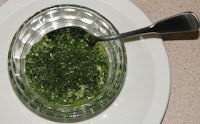 I make soup all year round, but I love, love, love soup on a cold day. My pantry is stocked with dried peas and lentils for spur-of-the-moment pots of goodness, but sometimes I break out more time-consuming recipes. On a rather blustery day, Mother Wolff Soup simmered on my stovetop for about four hours, requiring only the occasional stir. The soup came out more brothy than I expected -- especially in light of the ingredient list: lima beans and barley and rice and potatoes. Still, Kit went for a second bowlful, and leftovers improved from sitting in the fridge for a day or two, so the recipe is a keeper.
I make soup all year round, but I love, love, love soup on a cold day. My pantry is stocked with dried peas and lentils for spur-of-the-moment pots of goodness, but sometimes I break out more time-consuming recipes. On a rather blustery day, Mother Wolff Soup simmered on my stovetop for about four hours, requiring only the occasional stir. The soup came out more brothy than I expected -- especially in light of the ingredient list: lima beans and barley and rice and potatoes. Still, Kit went for a second bowlful, and leftovers improved from sitting in the fridge for a day or two, so the recipe is a keeper.A much quicker soup is Vegetarian Split Pea. It's stick-to-your-ribs thick and it goes from pantry to table in less than an hour.
Mother Wolff Soup
(adapted from Sundays at Moosewood Restaurant)
4 quarts water
1/2 cup dried lima beans, soaked overnight
1 cup cooked rice
1/2 cup barley
4 large garlic cloves, minced
1 Tbsp dried dill
1 bay leaf
2 Tbsp vegetable oil
1 cup diced onions
1 cup chopped celery
1 Tbsp sweet paprika
1 cup diced potatoes
1 cup diced carrots
1/2 tsp salt
ground black pepper
1 cup frozen peas
1 cup chopped canned tomatoes
1/4 cup chopped fresh parsley
In a large soup pot, combine water, drained limas, rice, barley, garlic, dill, and bay leaf. Bring to a boil, then lower heat, cover and simmer for 1.5 hours.
About an hour into the simmering time, heat the oil in a large frying pan and saute the onion and carrots for a few minutes. Mix in the paprika, potatoes, carrots, salt, and pepper. Cover and cook for a few minutes, stirring frequently, then add in the peas and cook, covered, a few minutes more.
Remove the bay leaf from the soup pot and add in the sauteed vegetables, tomatoes, and parsley. Add more salt and pepper if desired. Simmer the soup, on low heat, for another 1.5 to 2 hours, stirring occasionally.
Vegetarian Split Pea Soup
(adapted from various recipes)
1 Tbsp olive oil
1 large onion, diced
1 carrot, diced
7 cups water
1 lb dried split peas
1 Tbsp fresh thyme
Juice of one-half lemon (or more, to taste)
1/2 tsp to 1 tsp salt
Paprika to taste
In a 5-quart Dutch oven, heat the olive oil over medium-high heat and saute the onion and carrot until they begin to soften, about 5 minutes. Add the water, peas, and thyme to the pot; bring to a boil, then lower the heat and simmer the soup for about 40 minutes or until the peas are soft, stirring occasionally.
Measure out 4 cups of soup and puree them in a food processor. Return the pureed soup to the remaining soup in the pot. Add salt, lemon juice, and paprika to taste. (For a "meaty" taste, try this with smoked paprika. Or, for another flavor profile, leave out the paprika and sprinkle in curry powder.)





























